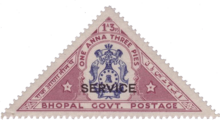
Indian pie

This article needs additional citations for verification. (January 2019) |

A pie (abbreviated as Ps) was a unit of currency in India, Burma and Pakistan until 1947. It was the smallest currency unit, equal to 1⁄3 of a pice, 1⁄12 of an anna or 1⁄192 of a rupee. During the mid-nineteenth century, one pie was worth 12 cowry.[1]

Minting of the pie ended in 1942, though it remained in circulation for a further five years. The pie was demonetized in 1947 as it had become practically worthless due to inflation during WW2.[note 1]

Notation
The first number is the number of rupees, the second is the number of annas (1/16), the third is the number of pices (1/64), and the fourth is the number of pies (1/192). Examples are below.

- Rs 1/15/3/2 = Rs 1.9947
- Rs 1/8/3 = Rs 1.546
- Rs 1/4 = Rs 1.25
Notes
- ^ Until 1966, India was a member of the sterling area, with the rupee pegged to the British pound sterling and having a value of 1s 6d, or 18 (old) pence; a pie was therefore worth 0.09 old pence or 3⁄8 of a farthing in 1947. In 1947, however, a single old penny had an estimated purchasing power of 14 new pence (in 2014 values). Therefore, a pie had a value of 1.3 pence in 2014. (Schedule of Par Values, Currencies of Metropolitan Areas, The Statesman's Year Book 1947, pg xxiii, Macmillan & Co.; measuringworth.com/ppoweruk/)
References
- ^ Laughlin, J. Laurence (September 1893). "Indian Monetary History". Journal of Political Economy. 1 (4): 593–596. doi:10.1086/250171. ISSN 0022-3808. S2CID 153692183.

See what we do next...
OR
By submitting your email or phone number, you're giving mschf permission to send you email and/or recurring marketing texts. Data rates may apply. Text stop to cancel, help for help.
Success: You're subscribed now !
